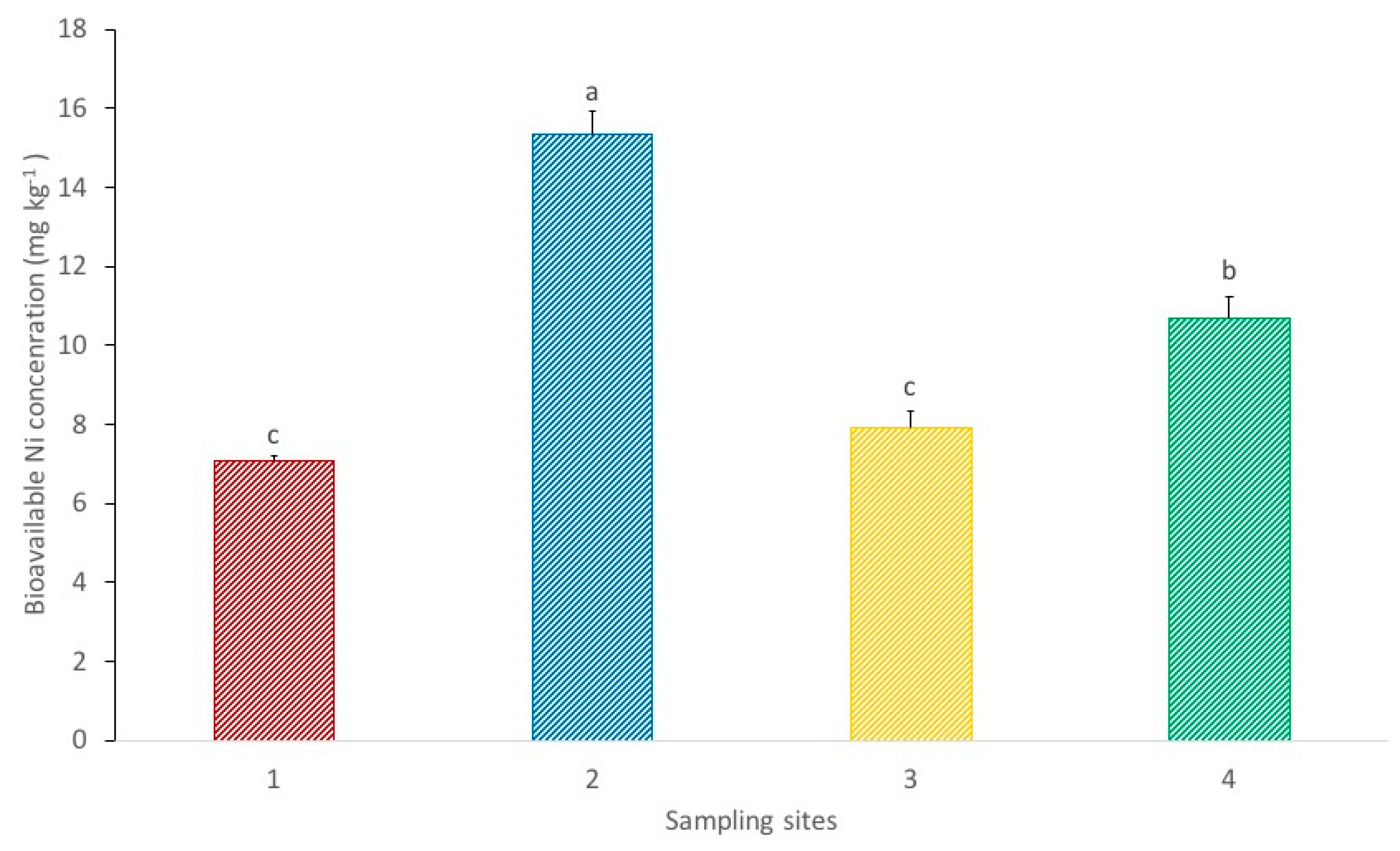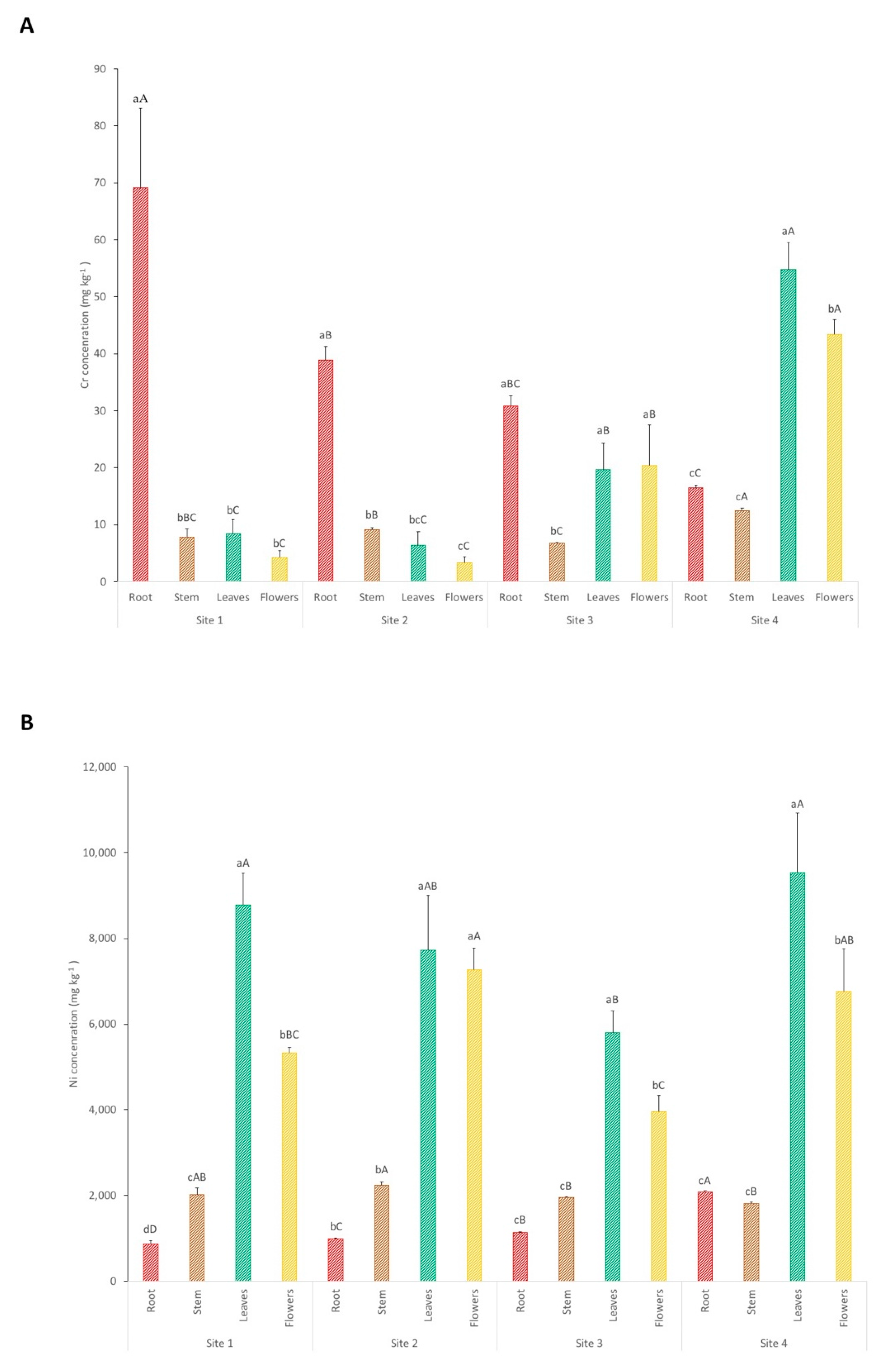Morais Ultramafic Complex: A Survey towards Nickel Phytomining
Abstract
:1. Introduction
Morais Massif Location and Geology
2. Materials and Methods
3. Results and Discussion
3.1. Soil
3.2. Plants
4. Conclusions
Author Contributions
Funding
Acknowledgments
Conflicts of Interest
References
- Kidd, P.S.; Bani, A.; Benizri, E.; Gonnelli, C.; Hazotte, C.; Kisser, J.; Konstantinou, M.; Kuppens, T.; Kyrkas, D.; Laubie, B.; et al. Developing Sustainable Agromining Systems in Agricultural Ultramafic Soils for Nickel Recovery. Front. Environ. Sci. 2018, 6, 44. [Google Scholar] [CrossRef]
- Kruckeberg, A.R. Geology and Plant Life: The Effects of Landforms and Rock Types on Plants; University of Washington Press: Seattle, WA, USA, 2004; ISBN 9780295984520. [Google Scholar]
- Alves, S.; Trancoso, M.A.; de Lurdes Simões Gonçalves, M.; Correia dos Santos, M.M. A nickel availability study in serpentinised areas of Portugal. Geoderma 2011, 164, 155–163. [Google Scholar] [CrossRef]
- Reeves, R.D. Hyperaccumulation of nickel by serpentine plants. In The Vegetation of Ultramafic (Serpentine) Soils; Baker, A.J.M., Proctor, J., Reeves, R.D., Eds.; Intercept: Andover, UK, 1992; pp. 253–277. [Google Scholar]
- Sobczyk, M.K.; Smith, J.A.C.; Pollard, A.J.; Filatov, D.A. Evolution of nickel hyperaccumulation and serpentine adaptation in the Alyssum serpyllifolium species complex. Heredity 2017, 118, 31–41. [Google Scholar] [CrossRef] [PubMed]
- Nkrumah, P.N.; Baker, A.J.M.; Chaney, R.L.; Erskine, P.D.; Echevarria, G.; Morel, J.L.; van der Ent, A. Current status and challenges in developing nickel phytomining: An agronomic perspective. Plant Soil 2016, 406, 55–69. [Google Scholar] [CrossRef]
- Brooks, R.R. Serpentine and Its Vegetation: A Multidisciplinary Approach; Dioscorides Press: Portland, OR, USA, 1988; Volume 40. [Google Scholar]
- Brady, K.U.; Kruckeberg, A.R.; Bradshaw, H.D., Jr. Evolutionary Ecology of Plant Adaptation to Serpentine Soils. Annu. Rev. Ecol. Evol. Syst. 2005, 36, 243–266. [Google Scholar] [CrossRef]
- Whiting, S.N.; Reeves, R.D.; Baker, A.J.M. Mining, metallophytes and land reclamation. Min. Environ. Manag. 2002, 10, 11–16. [Google Scholar]
- Alves, S.; Nabais, C.; de Lurdes Simões Gonçalves, M.; Correia dos Santos, M.M. Nickel speciation in the xylem sap of the hyperaccumulator Alyssum serpyllifolium ssp. lusitanicum growing on serpentine soils of northeast Portugal. J. Plant Physiol. 2011, 168, 1715–1722. [Google Scholar] [CrossRef] [PubMed]
- Díez Lázaro, J.; Kidd, P.S.; Monterroso Martínez, C. A phytogeochemical study of the Trás-os-Montes region (NE Portugal): Possible species for plant-based soil remediation technologies. Sci. Total Environ. 2006, 354, 265–277. [Google Scholar] [CrossRef]
- van der Ent, A.; Baker, A.J.M.; Reeves, R.D.; Pollard, A.J.; Schat, H. Hyperaccumulators of metal and metalloid trace elements: Facts and fiction. Plant Soil 2013, 362, 319–334. [Google Scholar] [CrossRef]
- Gonçalves, M.T.; Gonçalves, S.C.; Portugal, A.; Silva, S.; Sousa, J.P.; Freitas, H. Effects of nickel hyperaccumulation in Alyssum pintodasilvae on model arthropods representatives of two trophic levels. Plant Soil 2007, 293, 177–188. [Google Scholar] [CrossRef]
- Broadhurst, C.L.; Tappero, R.V.; Maugel, T.K.; Erbe, E.F.; Sparks, D.L.; Chaney, R.L. Interaction of nickel and manganese in accumulation and localization in leaves of the Ni hyperaccumulators Alyssum murale and Alyssum corsicum. Plant Soil 2009, 314, 35–48. [Google Scholar] [CrossRef]
- Goolsby, E.W.; Mason, C.M. Toward a more physiologically and evolutionarily relevant definition of metal hyperaccumulation in plants. Front. Plant Sci. 2015, 6, 33. [Google Scholar] [CrossRef] [PubMed]
- Boyd, R.S.; Martens, S.N. The raison d’être for metal hyperaccumulation by plants. In The Vegetation of Ultra- mafic (Serpentine) Soils; Baker, A.J.M., Proctor, J., Reeves, R.D., Eds.; Intercept Limited: Andover, MA, USA, 1992; pp. 279–289. [Google Scholar]
- Minguzzi, C.; Vergnano, O. Il contenuto di nichel nelle ceneri di Alyssum bertolonii. Atti della Soc. Toscana di Sci. Nat. A 1948, 55, 49–77. [Google Scholar]
- Brooks, R.R.; Lee, J.; Reeves, R.D.; Jaffre, T. Detection of nickeliferous rocks by analysis of herbarium specimens of indicator plants. J. Geochem. Explor. 1977, 7, 49–57. [Google Scholar] [CrossRef]
- Reeves, R.D.; Baker, A.J.M.; Jaffré, T.; Erskine, P.D.; Echevarria, G.; van der Ent, A. A global database for plants that hyperaccumulate metal and metalloid trace elements. New Phytol. 2018, 218, 407–411. [Google Scholar] [CrossRef] [PubMed]
- Baker, A.J.M.; Brooks, R.R. Terrestrial higher plants which hyperaccumulate metallic elements—A review of their distribution, ecology and phytochemistry. Biorecovery 1989, 1, 81–126. [Google Scholar]
- Dudley, T.R. A new Portuguese subspecies of Alyssum serpyllifolium Desfontaines. Agron. Lusit. 1967, 28, 69–76. [Google Scholar]
- Pinto da Silva, A.R. A flora e a vegetação das áreas ultrabásicas do nordeste transmontano. Agron. Lusit. 1970, 30, 175–364. [Google Scholar]
- Novo, L.A.B.; Castro, P.M.L.; Alvarenga, P.; da Silva, E.F. Phytomining of Rare and Valuable Metals. In Phytoremediation; Ansari, A.A., Gill, S.S., Gill, R., R. Lanza, G., Newman, L., Eds.; Springer International Publishing: Cham, Germany, 2017; pp. 469–486. ISBN 978-3-319-52379-8. [Google Scholar]
- Brooks, R.R.; Chambers, M.F.; Nicks, L.J.; Robinson, B.H. Phytomining. Trends Plant Sci. 1998, 3, 359–362. [Google Scholar] [CrossRef]
- van der Ent, A.; Baker, A.J.M.; Reeves, R.D.; Chaney, R.L.; Anderson, C.W.N.; Meech, J.A.; Erskine, P.D.; Simonnot, M.-O.; Vaughan, J.; Morel, J.L.; et al. Agromining: Farming for Metals in the Future? Environ. Sci. Technol. 2015, 49, 4773–4780. [Google Scholar] [CrossRef]
- Ribeiro, A.; Quesada, C.; Dallmeyer, R.D. Geodynamic evolution of the Iberian Massif. In Pre-Mesozoic Geology of Iberia; Dallmeyer, R.D., Martínez-Garcia, E., Eds.; Springer: Berlin/Heidelberg, Germany, 1990; pp. 397–410. [Google Scholar]
- Santos, F.J.; Ibarguchi, J.I.G.; Pin, C.; Paquette, J.L. Composite origin of an early Variscan transported suture: Ophiolitic units of the Morais Nappe Complex (north Portugal). Tectonics 2006, 25, 1–19. [Google Scholar] [CrossRef]
- Ghasemi, Z.; Ghaderian, S.M.; Rodríguez-Garrido, B.; Prieto-Fernández, Á.; Kidd, P.S. Plant species-specificity and effects of bioinoculants and fertilization on plant performance for nickel phytomining. Plant Soil 2018, 425, 265–285. [Google Scholar] [CrossRef]
- Shanker, A.K.; Cervantes, C.; Loza-Tavera, H.; Avudainayagam, S. Chromium toxicity in plants. Environ. Int. 2005, 31, 739–753. [Google Scholar] [CrossRef]
- Robinson, B.H.; Chiarucci, A.; Brooks, R.R.; Petit, D.; Kirkman, J.H.; Gregg, P.E.H.; De Dominicis, V. The nickel hyperaccumulator plant Alyssum bertolonii as a potential agent for phytoremediation and phytomining of nickel. J. Geochem. Explor. 1997, 59, 75–86. [Google Scholar] [CrossRef]
- Jones, J.B. Laboratory Guide for Conducting Soil Tests and Plant Analysis; CRC Press: Boca Raton, FL, USA, 2001; ISBN 9780849302060. [Google Scholar]
- Sheoran, V.; Sheoran, A.S.; Poonia, P. Phytomining: A review. Miner. Eng. 2009, 22, 1007–1019. [Google Scholar] [CrossRef]
- Romero-Freire, A.; Olmedo-Cobo, J.; Gómez-Zotano, J. Elemental Concentration in Serpentinitic Soils over Ultramafic Bedrock in Sierra Bermeja (Southern Spain). Minerals 2018, 8, 447. [Google Scholar] [CrossRef]
- Vithanage, M.; Kumarathilaka, P.; Oze, C.; Karunatilake, S.; Seneviratne, M.; Hseu, Z.-Y.; Gunarathne, V.; Dassanayake, M.; Ok, Y.S.; Rinklebe, J. Occurrence and cycling of trace elements in ultramafic soils and their impacts on human health: A critical review. Environ. Int. 2019, 131, 104974. [Google Scholar] [CrossRef]
- van der Ent, A.; Nkrumah, P.N.; Tibbett, M.; Echevarria, G. Evaluating soil extraction methods for chemical characterization of ultramafic soils in Kinabalu Park (Malaysia). J. Geochem. Explor. 2019, 196, 235–246. [Google Scholar] [CrossRef]
- Davies, F.T.; Puryear, J.D.; Newton, R.J.; Egilla, J.N.; Saraiva Grossi, J.A. Mycorrhizal fungi enhance accumulation and tolerance of chromium in sunflower (Helianthus annuus). J. Plant Physiol. 2001, 158, 777–786. [Google Scholar] [CrossRef] [Green Version]
- Chen, Y.X.; Zhu, Z.X.; He, Z.Y. Pollution behaviour of organic Cr(III) complexes in soil–plant system. Chin. J. Appl. Ecol. 1994, 5, 187–191. [Google Scholar]
- Deng, T.-H.-B.; van der Ent, A.; Tang, Y.-T.; Sterckeman, T.; Echevarria, G.; Morel, J.-L.; Qiu, R.-L. Nickel hyperaccumulation mechanisms: A review on the current state of knowledge. Plant Soil 2018, 423, 1–11. [Google Scholar] [CrossRef]
- Groeber, S.; Przybyłowicz, W.; Echevarria, G.; Montarges-Pelletier, E.; Barnabas, A.; Mesjasz-Przybyłowicz, J. Fate of nickel and calcium in seedlings of the hyperaccumulator Berkheya coddii during germination. Biol. Plant. 2015, 59, 560–569. [Google Scholar] [CrossRef]
- Novo, A.B. Plants to harvest rhenium: Scientific and economic viability. Environ. Chem. Lett. 2015, 13, 439–445. [Google Scholar] [CrossRef]
- Bani, A.; Echevarria, G.; Sulçe, S.; Morel, J.L. Improving the Agronomy of Alyssum murale for Extensive Phytomining: A Five-Year Field Study. Int. J. Phytoremediation 2015, 17, 117–127. [Google Scholar] [CrossRef]




| Site | pH | Conductivity (µS/cm) | Ca (mg kg−1) | Mg (mg kg−1) | Ca:Mg | P (mg kg−1) |
|---|---|---|---|---|---|---|
| 1 | 6.81 ± 0.03a | 84.70 ± 51.42a | 1359 ± 460b | 22,577 ± 2647a | 0.059 ± 0.014b | 295 ± 21a |
| 2 | 6.65 ± 0.02b | 101.30 ± 14.66a | 927 ± 133b | 26,028 ± 2105a | 0.036 ± 0.003b | 304 ± 25a |
| 3 | 6.50 ± 0.02c | 46.47 ± 12.16a | 3482 ± 712a | 23,606 ± 2325a | 0.147 ± 0.018a | 160 ± 9b |
| 4 | 6.39 ± 0.03d | 117.70 ± 112a | 3376 ± 672a | 21,117 ± 2594a | 0.159 ± 0.013a | 257 ± 13a |
| Site | pH | Ca:Mg | Ni (mg kg−1) | Cr (mg kg−1) |
|---|---|---|---|---|
| Portugal (Morais) | 6.6 | 0.036 | 2092 | 1240 |
| Spain (Melide) | 5.8 | 0.169 | 967 | 1263 |
| Austria | 6.1 | 0.065 | 1450 | 1840 |
| Greece | 7.2 | 0.050 | 2347 | - |
| Albania | 7.5 | 0.065 | 3140 | 1600 |
| Site | HA (mg) | TF | BF |
|---|---|---|---|
| 1 | 88.36 ± 4.62a | 4.91 ± 0.22a | 2.05 ± 0.34b |
| 2 | 93.80 ± 8.64a | 4.53 ± 0.35a | 1.98 ± 0.21b |
| 3 | 67.44 ± 1.05b | 2.84 ± 0.05b | 4.18 ± 0.20a |
| 4 | 95.56 ± 5.43a | 2.21 ± 0.11c | 3.77 ± 0.18a |
© 2019 by the authors. Licensee MDPI, Basel, Switzerland. This article is an open access article distributed under the terms and conditions of the Creative Commons Attribution (CC BY) license (http://creativecommons.org/licenses/by/4.0/).
Share and Cite
Alves, A.R.A.; Silva, E.F.; Novo, L.A.B. Morais Ultramafic Complex: A Survey towards Nickel Phytomining. Resources 2019, 8, 144. https://doi.org/10.3390/resources8030144
Alves ARA, Silva EF, Novo LAB. Morais Ultramafic Complex: A Survey towards Nickel Phytomining. Resources. 2019; 8(3):144. https://doi.org/10.3390/resources8030144
Chicago/Turabian StyleAlves, Ana R. A., Eduardo F. Silva, and Luís A. B. Novo. 2019. "Morais Ultramafic Complex: A Survey towards Nickel Phytomining" Resources 8, no. 3: 144. https://doi.org/10.3390/resources8030144






